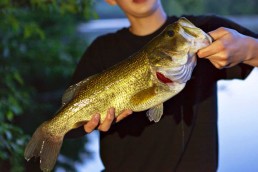Dog Days and Drop Shots
SHARE THIS POST
Nothing beats the joy of a sunny spring afternoon, the warmth of a sheltered bay, and a bobber going down again and again.
Until, of course, the feisty fish move out of shallow water, in favor of deeper haunts more conducive to summer feeding. Good things, it seems, never last forever.
What’s a poor angler to do when the fish stop biting where just last week they were ridiculously easy to find and catch? Give up until the next spring fling in the shallows? Hardly! Fish gotta eat. If they’re not biting where they were, they must be biting somewhere else.
So let’s solve the mystery of catching trophy bluegills in summer…
Summer exodus
Once spring spawning is complete, larger bluegills desert shallow bays and main lake reed beds. On most natural lakes in Minnesota, the Dakotas, Wisconsin and Michigan, they initially relate to the outer fringes of deep weeds rimming the basin of the lake.
Early on—like mid-June—fish begin collecting into schools, with suspension common. Bluegills hug the developing weeds during the day, often rising upward on calm evenings to pluck emerging insects off the water’s surface. You see the telltale spines of their dorsal fins poking above the still water as they cruise, barely subsurface. Once they spot their prey, audible “smacks” and telltale ripples reveal packs of ‘gills sucking insects off the mirror-like boundary between air and water.
If you enjoy fly-fishing, it’s the perfect time to lay tiny dry flies on their dinner table, tempting bluegills to rise to the occasion. And even if the conditions aren’t ideal, with wind rippling the water, ‘gills usually still respond to a variety of subsurface lures like swimming small jigs, casting and retrieving 2-inch crankbaits and yes, even the old standby: a bobber, split shot and #6 hook, baited with a piece of nightcrawler.
All goes well for a few weeks, with ‘gills of all sizes feeding topside with abandon. Until one day…the larger bluegills seem to disappear.
Did they stop biting until next spring? Nope. They’ve moved.
Oddly enough, we can still catch loads of small to mid-size bluegills throughout the shallows: around docks, along inside weed lines, atop mid-depth weed flats and along the outer edge of the deepest weeds. So logically, the largest ‘gills must either be deeper or suspended.
Interestingly, when you cast-and-swim small jigs, or troll small crankbaits from the surface down to, say, 15 or 18 feet, you catch crappies. Loads and loads of crappies. That’s because, in early to mid-summer summer, schools of crappies like to suspend at mid depths and patrol the outer edges of weed beds, becoming particularly active in the evening.
So, we have the crappies wired—at least for a while. Now, what about the biggest bluegills—those elusive 9-, 10-, even 11-inchers that approach and bypass the 1-pound mark? The next obvious step is to try fishing deeper, on or near the bottom.
Where they lurk
During mid to late-summer, large bluegills often drop out of deep weed beds, preferring transition areas where the base of the drop-off meets modestly deep basins in the 15- to 30-foot depth range. The tips of long points, and the perimeters of offshore humps, draw some of the biggest ‘gills in the lake. Bull ‘gills often line up along the edge formed where the harder bottom of the drop-off meets the softer mud basin, where the fish feed on a mixture of emerging insects, larvae and minnows.
Sometimes, key features along these edges really concentrate schools of gills, likea patch of gravel at the base of the drop-off, where you occasionally feel your sinker tap and scratch across patches of harder bottom or sandgrass. It’s not rocky enough to be snaggy, which is typical of good bluegill spots. Were it filled with rock and boulders, it would more likely attract other species like walleyes or smallmouth bass. Instead, it’s a bluegill bonanza.
Next, consider how big ‘gills usually orient to the bottom. Unlike walleyes, they seldom lie right on the basin. Instead, schools of bluegills usually hover perhaps a foot or two off bottom, slowly milling around, patiently pecking at small food items they discover. So you can see them on your electronics if you know what to look for.
Given the depth of the water and relatively small size of your quarry, good electronics are a must. They allow you to do a lot of searching before you even wet a line. And they help hold you with pinpoint precision atop key bluegill spots.
Get the drop on deep summer ‘gills
So, what do you need to catch big bluegills—those misshapen brutes whose blunt foreheads are built like bulldozers?
Are you enjoying this post?
You can be among the first to get the latest info on where to go, what to use and how to use it!
Admittedly, it can be a bit of a challenge, because you can’t use large, bulky or heavy lures. Bluegills have small mouths—even the largest bull bluegills over a pound. So, you need a system that efficiently gets small baits down to deeper depths, allowing you to fish perhaps 20 to 30 feet deep and cover enough water to find schools of roving bluegills.
As far as rigs go for these deep-water bruisers, you have a couple of options.
Obviously, a slip sinker rig dressed with small live baits, like panfish leeches or live nightcrawlers, can be extremely effective. It’s just like live bait rigging for walleyes.
Better yet are drop-shot rigs, which are easily constructed out of a few simple components.
First, use a palomar knot to attach a size 6 Sure Set Drop Shot hook about 2 feet from the end of the line. Or even easier, a size 6 VMC Spin Shot hook, which features an innovative swivel attachment that eliminates line twist.
Next, clip a drop-shot sinker to the end of the line to position your bait 1 1/2 to 2 feet above bottom. You can further adjust how far off bottom the bait rides simply by sliding the sinker up or down the line. If the sinker snags bottom, a firm pull should slide the sinker off the line, preventing you from losing the baited hook.
Speaking of bait, a wide variety of tiny soft baits are ideal for catching big ‘gills in deep water. Short crawler imitations, tiny tubes, and subtle insect imitations do the trick. Most of the time, 1- to 2-inch soft baits are best, although you can use 3-inch or longer crawler simulations when bigger ‘gills prefer a mouthful to a morsel.
In a nutshell, all you need do is slowly drift or troll along at the right depth level, tapping your sinker on and off bottom with subtle lifts and drops, to dance your baits in front of the bluegills’ eyes and noses. It tempts. It teases. And it gets results. And once you hook into some of these bruisers, you’ll be amazed at how hard they fight. They turn sideways, circling again and again as you try to lift them upward, fighting every inch of the way. It’s like trying to lift a frying pan on steroids.
What’s that, you say? You’re not a bass angler, and don’t have any of those fancy bassin’-style drop-shot sinkers? In a pinch, substitute a couple of larger 3/0 size split-shot sinkers and…well…pinch them on the end of your line. Perhaos they aren’t not as fashion forward, but they’re just as effective. And truth be told the bluegills won’t know the difference.
And another thing: If you’re in short supply of small plastic soft baits, and really prefer fishing with live critters for panfish, no problem at all. Pick up some nightcrawlers—preferably the shorter 3-inchers labeled “panfish crawlers” at the local bait shop—and nip the head end on your hook. Or, try some small panfish leeches, hooked through the suction cup end. Bull ‘gills can’t resist ‘em.
Been digging in the garden lately? You’ll often find interesting grubs there. Try ‘em. Especially the big, white fat ones.
Down South, you’d probably be catching crickets for bait before you hit the water for bluegills or shellcrackers. Up North, check the yard or along the shoreline to see what kinds of bugs are falling off the trees and bushes into the water these days. Collect a few in a plastic container, and try drop-shotting them for bruiser ‘gills.
In all cases, long rods are imperative in this style of fishing. 7-foot, medium light spinning rods are excellent. They have soft tips to detect light bites, yet plenty of backbone to set the hook and fight bull gills swirling on the line. And sufficient cushion to prevent breaking 2- to 6-pound-test fluorocarbon line, which matches nicely with a size 10 or 15 lightweight spinning reel. Plus, long rods allow you to set up a deadly “jiggling” action on your bait by merely quivering your wrist up and down.
The fact is, the drop-shot technique is easy and effective. And it works equally well with any of the baits mentioned here—live or artificial. And anybody can do it.
The biggest obstacle to success is simply recognizing the locational pattern, and fishing the right kinds of areas, at the right depths. Because that’s where the biggest bluegills in the lake are during mid to late-summer. And the pattern will hold firm until, well, it doesn’t because they’ve moved again.
When that happens, no problem. We know the drill. We’ll figure out where they’re headed, and then head them off at the pass.
MWO
SHARE THIS POST
Did you enjoy this post?
You can be among the first to get the latest info on where to go, what to use and how to use it!
Dave Csanda
Dave Csanda has enjoyed 40 years in the fishing communications industry at In-Fisherman, Angling Edge and now, as editor of MidWest Outdoors. He is an inductee of both the Minnesota and National Fresh Water Fishing Halls of Fame.



